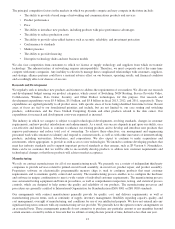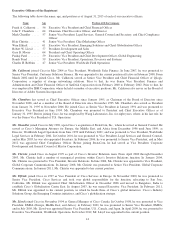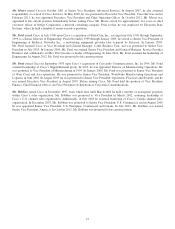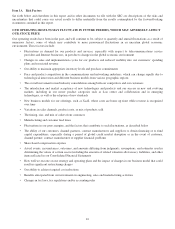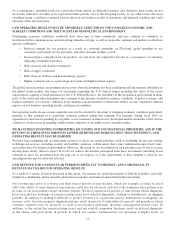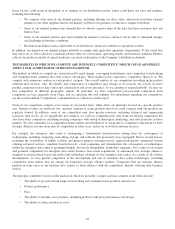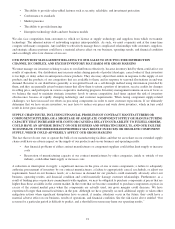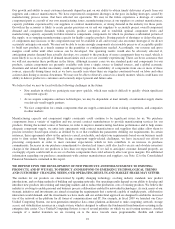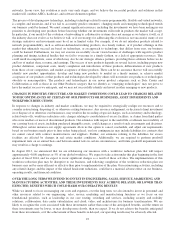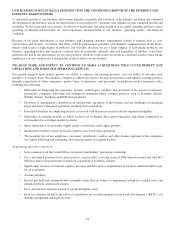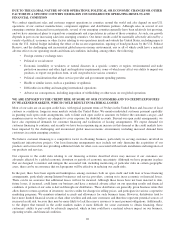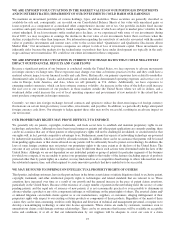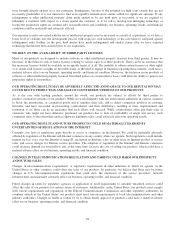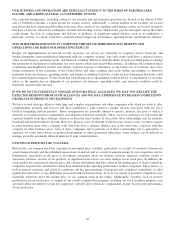Cisco 2013 Annual Report Download - page 30
Download and view the complete annual report
Please find page 30 of the 2013 Cisco annual report below. You can navigate through the pages in the report by either clicking on the pages listed below, or by using the keyword search tool below to find specific information within the annual report.Our growth and ability to meet customer demands depend in part on our ability to obtain timely deliveries of parts from our
suppliers and contract manufacturers. We have experienced component shortages in the past, including shortages caused by
manufacturing process issues, that have affected our operations. We may in the future experience a shortage of certain
component parts as a result of our own manufacturing issues, manufacturing issues at our suppliers or contract manufacturers,
capacity problems experienced by our suppliers or contract manufacturers, or strong demand in the industry for those parts.
Growth in the economy is likely to create greater pressures on us and our suppliers to accurately project overall component
demand and component demands within specific product categories and to establish optimal component levels and
manufacturing capacity, especially for labor-intensive components, components for which we purchase a substantial portion of
the supply, or re-ramping manufacturing capacity for highly complex products. During periods of shortages or delays the price
of components may increase, or the components may not be available at all, and we may also encounter shortages if we do not
accurately anticipate our needs. We may not be able to secure enough components at reasonable prices or of acceptable quality
to build new products in a timely manner in the quantities or configurations needed. Accordingly, our revenue and gross
margins could suffer until other sources can be developed. Our operating results would also be adversely affected if,
anticipating greater demand than actually develops, we commit to the purchase of more components than we need, which is
more likely to occur in a period of demand uncertainties such as we are currently experiencing. There can be no assurance that
we will not encounter these problems in the future. Although in many cases we use standard parts and components for our
products, certain components are presently available only from a single source or limited sources, and a global economic
downturn and related market uncertainty could negatively impact the availability of components from one or more of these
sources, especially during times such as we have recently seen when there are supplier constraints based on labor and other
actions taken during economic downturns. We may not be able to diversify sources in a timely manner, which could harm our
ability to deliver products to customers and seriously impact present and future sales.
We believe that we may be faced with the following challenges in the future:
• New markets in which we participate may grow quickly, which may make it difficult to quickly obtain significant
component capacity
• As we acquire companies and new technologies, we may be dependent, at least initially, on unfamiliar supply chains
or relatively small supply partners
• We face competition for certain components that are supply-constrained, from existing competitors, and companies
in other markets
Manufacturing capacity and component supply constraints could continue to be significant issues for us. We purchase
components from a variety of suppliers and use several contract manufacturers to provide manufacturing services for our
products. During the normal course of business, in order to improve manufacturing lead-time performance and to help ensure
adequate component supply, we enter into agreements with contract manufacturers and suppliers that either allow them to
procure inventory based upon criteria as defined by us or that establish the parameters defining our requirements. In certain
instances, these agreements allow us the option to cancel, reschedule, and adjust our requirements based on our business needs
prior to firm orders being placed. When facing component supply-related challenges, we have increased our efforts in
procuring components in order to meet customer expectations which in turn contribute to an increase in purchase
commitments. Increases in our purchase commitments to shorten lead times could also lead to excess and obsolete inventory
charges if the demand for our products is less than our expectations. If we fail to anticipate customer demand properly, an
oversupply of parts could result in excess or obsolete components that could adversely affect our gross margins. For additional
information regarding our purchase commitments with contract manufacturers and suppliers, see Note 12 to the Consolidated
Financial Statements contained in this report.
WE DEPEND UPON THE DEVELOPMENT OF NEW PRODUCTS AND ENHANCEMENTS TO EXISTING
PRODUCTS, AND IF WE FAIL TO PREDICT AND RESPOND TO EMERGING TECHNOLOGICAL TRENDS
AND CUSTOMERS’ CHANGING NEEDS, OUR OPERATING RESULTS AND MARKET SHARE MAY SUFFER
The markets for our products are characterized by rapidly changing technology, evolving industry standards, new product
introductions, and evolving methods of building and operating networks. Our operating results depend on our ability to develop and
introduce new products into existing and emerging markets and to reduce the production costs of existing products. We believe the
industry is evolving to enable personal and business process collaboration enabled by networked technologies. As such, many of our
strategic initiatives and investments are aimed at meeting the requirements that a network capable of multiple-party, collaborative
interaction would demand, and the investments we have made and our architectural approach are designed to enable the increased
use of the network as the platform for all forms of communications and IT. For example, in fiscal 2009 we launched our Cisco
Unified Computing System, our next-generation enterprise data center platform architected to unite computing, network, storage
access, and virtualization resources in a single system, which is designed to address the fundamental transformation occurring in the
enterprise data center. Cisco Unified Computing System is one of several priorities on which we are focusing resources. Another
example of a market transition we are focusing on is the move towards more programmable, flexible and virtual
22


